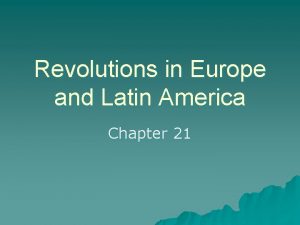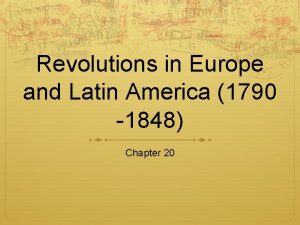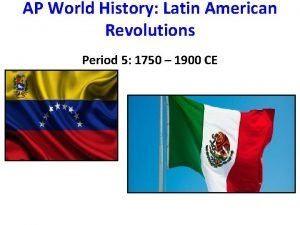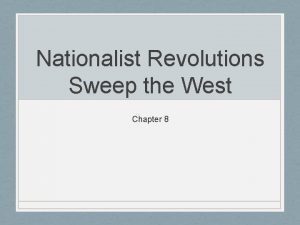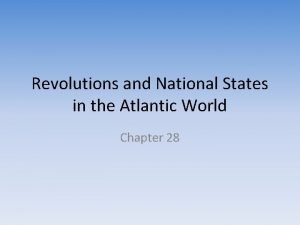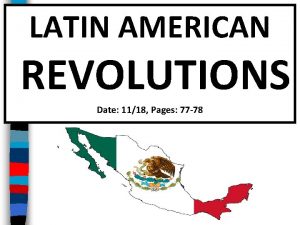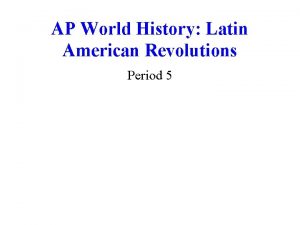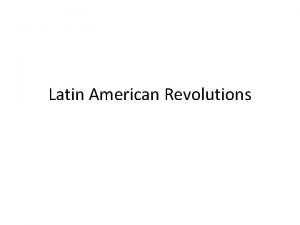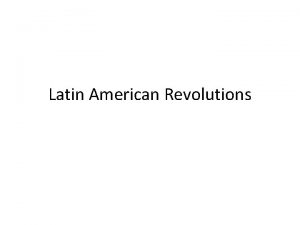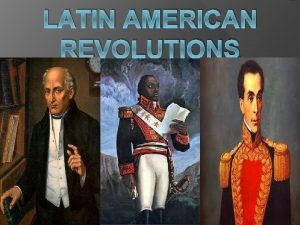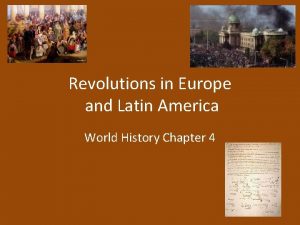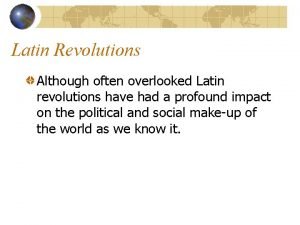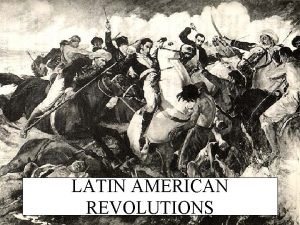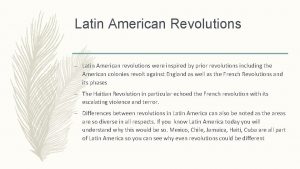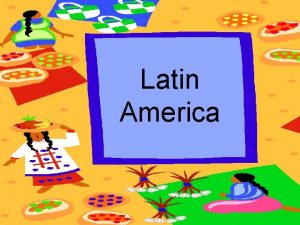Revolutions in Europe and Latin America World History











- Slides: 11

Revolutions in Europe and Latin America World History Chapter 4

An Age of Ideologies • Conservatives Prefer the Older order – Congress of Vienna • Nobles of Europe should work together to suppress liberal thinking – Peasants largely support a more conservative structure – Established churches – Believe that talking about natural rights leads to chaos – Suppress freedom of the press, speech. – Use troops to suppress rebellion

Liberals and Nationalists Seek Change • Inspired by the enlightenment and the French Revolution • Mostly comprised of the Bourgeoisie • Wanted: – – – Written Constitution Separation of powers Natural rights defended Freedom of religion Universal male suffrage Free markets • Nationalists seek own states • Nations have a commonality of language, history, beliefs and culture, but not necessarily political boundaries. • Nationalism usually also includes intolerance and persecution of others

Central Europe Challenges the Old Order – Revolutions spring up all over Europe despite harsh measures • Serbia seeks independence (1804 -1813) – During the time of Napoleon, the Serbs rose up against their Ottoman rulers, unsuccessfully – After 1815, the Serbs turned to Russia for assistance (similar heritage) • Greece Revolts (1821 -1830) – Britain, France, and Russia force the Ottomans to accept Greek independence – However, Greece’s allies forced them to accept a German king (fearing nationalistic revolutionary ideas) • More Challenges – Spain, Portugal, The Italian States – France and Austria move to suppress, but Liberal ideas continue to flourish

Revolutions of 1830 and 1848 • A Milder French Revolution in 1830 – Louis XVIII (Congress of Vienna) • Supported some reforms – Charles X • Absolutist, suspended reforms • People rose up, Charles X fled to England – Moderates call for a constitutional monarchy • Louis Philippe, citizen king, popular for a time • Belgium wins independence 1830 – Made a part of Holland in 1815 • Polish Nationals rebel 1830, crushed by Russia – Poland split between different powers, harder to unite

The French are Revolting!@ • Once again, discontent, corrupt government, and poor harvests led to another French Revolution in 1848. – Louis Philippe abdicated – Second Republic formed • Socialists, bourgeoisie, liberals, and radicals • Set up government work programs • Socialists wanted to have far reaching social and economic reforms, but control was taken over by upper and middle class bourgeoisie factions, and the work programs were canceled. • Workers revolted, and the bourgeoisie put them down violently. – Nephew of Napoleon, Louis Napoleon, was elected president, then later took the position of Emperor. (plebiscite)

Revolution Surges Through Europe 1848 • “When France sneezes, Europe catches cold. ” • Austrian Empire – Students and workers demand reforms • Italy – Nationalism and unification become goals • Germany – Students and workers force Prussian King Frederick William IV to sign a constitution and enact other reforms, little is gained. • (Japan) – Meiji Restoration 1868

Revolts in Latin America • Discontent Fans the Fires • About the same time that enlightenment ideals were causing discontent in Europe, it was doing the same in the Americas. Three hundred years of racial, social, political and economic subjugation created fertile ground for revolutionary thinking. – Social and Ethnic Structures Cause Resentment • • Peninsulares (Born in Spain) Creoles (European descendant) Mestizos (Mixed European, Native American) Mulattoes (Mixed European, African) – The Enlightenment Inspires Latin Americans • Enlightenment ideals circulate among the educated Creole population, and some of them went to Europe to see these revolutions in person. – Napoleon Invades Spain • When Napoleon invaded Spain (the first Napoleon, 1808), Latin Americans saw this as a chance to revolt, during a time of Spanish weakness

Slaves Win Freedom for Haiti • Toussaint L’Ouverture Leads a Slave Revolt – A self educated slave, Toussaint became impassioned by the talk of liberty and equality, and led the people of Haiti in revolt of their French masters. – Though untrained, Toussaint was a natural field general and inspirational speaker, leading his army of ex slaves against the French, British, and Spanish. • Haiti Wins Independence – The French violate a truce, and capture Toussaint, sending him to a cold mountain prison, to die a year later. – Even without Toussaint, the Haitians were now strong enough to hold out against the French, and when the French were decimated by yellow fever, forced the French to surrender.

Mexico and Central American Revolt • Father Hidalgo Cries out for Freedom – – – • Jose Morelos Continues the Fight – – • Another priest, Jose Morelos led an army of rebels for 4 years before he was captured and shot (1815). A combined force of Creoles and Spanish forces hunted down the survivors Mexico Wins Independence – – • Parish priest of Dolores, called for people to rise up for independence Many Mestizoes and Native Americans joined up with him. In front of Mexico City, Father Hidalgo called for an end to slavery and other reforms. He was captured and executed. (1810) In 1820, popular sentiment had shifted in Spain, and reformers there called for a constitution. Fearing liberal reforms, a Mexican Creole General named Agustin de Iturbide stopped hunting rebels, joining forces with them to overthrow the Viceroy and Spain’s control. Iturbide claims the title Emperor of Mexico, but lasts less than a year. New Republics Emerge in Central America – Spain’s power being broken, all of the Central American nations declared independence. • • • Guatemala Nicaragua Honduras El Salvador Costa Rica

Revolution Ignites South America • Bolivar Begins the Fight – Liberates Venezuela (1810), but conservatives take over. Civil war rages for years. – Not always successful, twice Simon Bolivar was exiled to Haiti. Goes on to Topple the center of Spanish rule in Bogota, Bolivia. • San Martin Joins the Fight – Also a Creole, educated in a European Military Academy, he also led a force across the Andes from Argentina, to strike at the Spanish in Chile. – Joins forces with Bolivar, independence gained for all but Brazil (under Portuguese control) • Freedom Leads to Power Struggles – By 1824 most of Latin America is independent, but they are wary of each other, and in every case, the more conservative Creoles are in charge, instead of more populist liberal government. • Brazil Gains Independence – The King of Portugal’s son, Dom Pedro, was left in charge of Brazil by his father who advised him, “if there is a revolution, proclaim it yourself and put the crown on your own head. ” – Following his father’s advice, Dom Pedro declared himself Emperor of an independent Brazil when confronted by rebels. He signed a constitution and allowed many reforms. – His rule lasted 67 years (1822 -1889), but upon his death, turmoil claimed the monarchy and Brazil became a republic.
 Revolutions in europe and latin america section 2 quiz
Revolutions in europe and latin america section 2 quiz Revolutions in europe and latin america
Revolutions in europe and latin america Latin americans in france
Latin americans in france Why called latin america
Why called latin america Europe asia north america south america
Europe asia north america south america Revolutions sweep europe
Revolutions sweep europe Europe faces revolutions
Europe faces revolutions Rap of the states
Rap of the states Revolutions and national states in the atlantic world
Revolutions and national states in the atlantic world Latin american revolutions date
Latin american revolutions date Ap world history chapter 25 africa and the atlantic world
Ap world history chapter 25 africa and the atlantic world Jose de san martin ap world history
Jose de san martin ap world history
